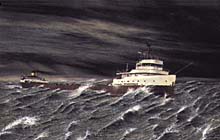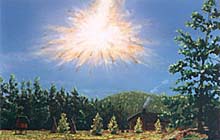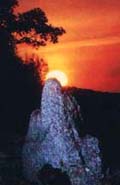|
|


Editorial
|
Fragments
|
Cave of the Mounds
|
Thunderbird
|
Sphinx IV
Register
for our Hall of Records Newsletter!
Questions? Comments? Suggestions? Advertising? Press Releases?
Contact us!


Launched in 1958, the Edmund Fitzgerald, was the largest ship to sail the
Great Lakes. Its sinking on Nov. 9, 1975 was immortalized in Gordon
Lightfoot's song,
"The Wreck of the Edmund Fitzgerald"
and it remains a favorite in Great
Lakes folklore today. Painting copyright
Robert J. Tyrrell
|
|
In 1958, the Great Lakes Engineering Works built the bulk freighter
Edmund Fitzgerald,
designed to carry large loads up and down the Great Lakes. At 729 feet long, it was the largest
ship on the Great Lakes, and it remained so until 1969. Up to that time, its service record
showed no signs of problems or incidents that would foreshadow its fate yet to come.
However, starting in 1969, the Edmund Fitzgerald began to have serious problems. On September 6
of that year, she ran aground near the Soo Locks, which resulted in widespread damage both to the hull
and to the superstructure, requiring an extensive overhaul. After that problems would continue
to plague the Fitzgerald, with cracks regularly forming on the ship's keel, requiring constant
repair.
In April of 1970, the Edmund Fitzgerald collided with another ship, the S.S. Hochelaga. In
September of that year, she struck a lock wall suffering further damage. In the meantime, the
operating safety standards of the ship had been increasingly lowered in order to increase profit
margins. In 1973, the Fitzgerald's official load capacity was increased to the
point where the ship now sat over three feet lower in the water than it was originally designed to.
Over the next few years, more collisions, more cracks in the keel, the loss of an anchor, and
damage to several of her topside hatches (which would allow water to enter the interior of the ship)
made the Edmund Fitzgerald ripe for disaster.
On the morning of November 10, 1975, the Edmund Fitzgerald took on a load of taconite (iron ore
pellets) at Superior, Wisconsin, headed to Zug Island in the Detroit River. On the way to its
destination, the Fitzgerald was overtaken by a sudden, violent storm which generated
huge waves, some up to 30 feet tall. During the storm, both the Fitzgerald's radars went out,
and the local lighthouse at Whitefish Point lost power, bringing down both its light and radio
beacons. Helped out by its sister ship the Arthur Andersen, the Fitzgerald, listing
and taking on water, continued on its course. However, after the Fitzgerald entered a
squall line, the Andersen lost visual contact with her, and then lost radar contact as well.
Three days later, on the fourteenth, wreckage was recovered, but wasn't confirmed as the Fitzgerald
until six months later. The fury of the lake storm was so great that the Fitzgerald was found in
two pieces, each 100 feet from each other, with the middle 200 feet of the ship totally disintegrated.
All hands were lost on this massive ship which, like the Titanic, was believed to be practically
unsinkable. Experts now understand that lake storms, previously thought to be less powerful than
ocean-going storms, may actually be worse as the smaller lakes are more easily whipped up by winds.
In 1995, the bell of the Fitzgerald was recovered and brought to
Michigan State University
for restoration, at the request of the families of those sailors lost in the shipwreck. It is
currently stored at the
Great Lakes Shipwreck Museum
located at the old
Whitefish Point Lighthouse
, just northeast of Paradise, Michigan, near Sault St. Marie. For more info,
contact the Great Lakes Shipwreck Historical Society, 111 Ashmun St., Sault Ste.
Marie, MI 49783; phone: 1-877-SHIPWRECK.



|
|
|


The Tunguska blast, in Siberia, was believed to be a comet that exploded in the atmosphere just
above the surface of the Earth. Minutes after the blast, over 1,500 square miles of Siberian
forest was knocked flat, much of it totally incinerated. Painting copyright
William K. Hartmann
|
|
On the morning of June 30, 1908, Russian peasants saw what appeared to be a shining column of light
descend and move rapidly across the sky, from the southwest to the northeast. Just before the brilliant
head of the column would have touched down in Siberia, however, it exploded with a mighty crash that
could be heard over 300 miles away, and felt over 600. At 100 miles away, the object could be seen as
a fireball in the sky; at 40 miles, people were thrown to the ground or knocked unconscious. As close
as 20 miles from the site, some reindeer herders were lifted off of their feet and thrown for some distance,
one man dying from his injuries. Near the epicenter of the blast, whole herds of reindeer were instantly
incinerated. Seismic stations felt tremors from the blast over 3,000 miles away.
The Tungus tribesmen and Russian fur traders that day were lucky to survive the near impact of what is
now commonly believed to be the near-miss of an asteroid or comet. This object entered Earth's atmosphere
at the angle of 30-35 degrees, skimming through our atmosphere until the heat of its atmospheric entry
caused it to explode some five miles above the surface of the earth. The fiery trail from this object was
seen as far away as Great Britain, and stretched all the way from Great Britain to Siberia. The blast was
so powerful it felled trees outward in a radial pattern over an area of over 1,500 square miles. At the
epicenter of the blast, the forest fires created a tremendous burning column of fire, visible hundreds of
miles away, creating thunderstorms of a ferocity nearly as loud and intense as the blast itself.
Accompanying this massive pillar of fire was a pillar of smoke and ash, which sent millions of tons of
soot and ash around the world, darkening the skies around the world. At night, the burning fire in the
sky, aided by the reflection of the high-level clouds of soot and ash, created enough nighttime
luminescence to read a watch or even a newspaper by. There were even magnetic storms associated with the
blast, similar to those created by atmospheric nuclear testing. Furthermore, there have been a series of
unusual biological changes in the region, including an accelerated growth of biomass near the epicenter
of the blast and immediately before it, and an increased rate of biological mutations, among others.
Lucky for us, the object decided to explode over sparsely populated Siberia, rather than heavily populated
Europe. Estimates for the loss of life range in the hundreds of thousands had the explosion occurred over
central Europe but, ironically, had it exploded over Europe, both World Wars might have been avoided and
many more lives would have been saved.
The Tunguska area is only a place to be visited by the hardy traveler. Located in Central Siberia, the
traveler will have to contend with "walls" of mosquitos and hundreds of miles of swampy marshland, not
to mention superstitious Tungus tribesmen who consider the area to be sacred. The epicenter of the
blast is best reached by helicopter, as the Tunguska region is still fairly primitive, nearly a century
later. Check out the following links for more information:

 Tunguska Meteorite Paradox (1908-2000)
Tunguska Meteorite Paradox (1908-2000)
 TUNGUSKA: The Cosmic Mystery of the Century
TUNGUSKA: The Cosmic Mystery of the Century
 1908 Siberian Explosion
1908 Siberian Explosion


|
|

|


|
|
The "Marching Bear Mound Group" one of the largest groups of effigy mounds still remaining. This group
consists of ten bears, three birds, and two linear mounds of unknown meaning. These mounds were used for
burial purposes, and the reason for the animal shape is unknown. Effigy mounds are unique to North America,
and are primarily located in the Upper Mississippi Valley region. This mound group is just one feature of
the Effigy Mounds National Monument, located in northeastern Iowa. Image copyright
Effigy Mounds National Monument (National Park Service)
|
|
Effigy mounds - mounds built in the shape of animals - are unique to the United States. Almost all,
with the exception of the Serpent Mound in southern Ohio, lay primarily in the Upper Mississippi
River Valley region. The bulk of the mounds sit on the northeastern border of Iowa, and spread across
the border to northwestern Illinois, southwestern Wisconsin, and southeastern Minnesota. In order to
protect these easily damaged antiquities, President Truman designated the area a national parkground
in 1949, known today as the Effigy Mounds National Monument.
The park is geographically divided into two basic areas: the Headquarters Section, which includes the
north and south units, and Sny Magill, which is 11 miles south of the Headquarters section. The Sny
Magill area has the majority of the mounds, totaling over 100. The Monument area encompasses close to
200 mounds in total, 26 of which are identifiable as particular animal types such as bears and birds.
The construction of these mounds date from 500 b.c. to a.d. 1500 - fairly old from North American
archaeological standards. The reason for the animal shapes is not clear, but it is known that the mounds
were used at least partly for burial purposes.
The first Native Americans entered the area of what is now northeast Iowa around 12,000 years ago. These
were primitive hunter-gatherers, that built no permanent settlements, and left little in the way of
material culture except broad, leaf-shaped spear-points and bone and copper awls for sewing. The first
mounds were built by the descendants of these first peoples, referred to today as the Red Ocher Culture,
whose material remains have been carbon dated back to 500 b.c. - during the Early Woodland Period. These
people earned their name from the layer of red ochre that covered the floors of their burial chambers.
The Red Ochre people are believed to have created conical and linear shaped mounds until around 100 b.c.,
when they were replaced by an unidentified Hopewellian culture, which inhabited the area from 100 b.c.
to a.d. 600.
The peoples who built the effigy mounds coexisted with this unknown Hopewellian culture for a century or so
before their culture supplanted them entirely. These Effigy Mounds people were more or less the same as
their predecessors, except in the fact that their burial mounds were animal-shaped, and that they buried
their dead with few material artifacts. They also differed from the Hopewells in that they used copper for
tools. The Effigy Mounds people lasted in the area until around a.d. 1400, when they were replaced in the
area by Indians of the Oneota culture. This Oneota culture were the people who were contacted by the
Lewis and Clark expedition in the 1800s.
Major features of the park include the museum, and a self-guided walking tour of the park, which include
the Little Bear Mound, the Marching Bear Mound Group, and various other mound groups and natural features.
Scheduled guided walks are given from Memorial Day to Labor Day.
Effigy Mounds National Monument is located in northeastern Iowa, right along the Mississippi River, three
miles north of Marquette, Iowa. The park is open daily 8 a.m. to 4:30 p.m. with extended hours June 7 to
September 7 and weekends in October, 8 a.m. to 6 p.m. It is closed Thanksgiving Day, Christmas Day,
and New Year's Day. For more information, contact: Effigy Mounds National Monument, 151 Hwy 76, Harpers
Ferry, IA 52146; phone: (319)873-3491. 
 ParkNet -- Effigy Mounds National Monument
ParkNet -- Effigy Mounds National Monument
 ParkNet -- Effigy Mounds National Monument (Expanded Version)
ParkNet -- Effigy Mounds National Monument (Expanded Version)
 Minnesota State University Anthropology Dept.
Minnesota State University Anthropology Dept.


|
|
|


Located near the town of Salem, New Hampshire, America's Stonehenge is a 4000-year-old
collection of megalithic rocks arranged in such a way as to perform a calendrical function, much
like the famous British Stonehenge from which it derives its name. Unlike the British Stonehenge,
however, it includes a sacrificial altar, and an oracle, structures normally not seen outside of
Europe, leading some to believe that it was created by ancient Europeans. Photo copyright
The Unnatural Museum
|
|
Recently scholars have shown increased interest in megalithic structures right here in North America.
One of the most famous of these megalithic structures (mega meaning "huge", lithic
meaning "stone") is Mystery Hill, more commonly known as "American Stonehenge". American Stonehenge
is a functional solar and lunar calendar, and it attracts thousands of visitors every year who come
to see the beautiful lighting effects that occur at predictable intervals each year.
American Stonehenge, located in what is now North Salem, New Hampshire, is a megalithic stone circle
much like those found in England and Ireland, leading some to speculate that it is Celtic in origin.
The presence of ancient Celtic-like runes on many of the stones throughout the area, as well as the
general layout and structure of the site, lends strong support to this theory. The site has been
dated as being up to 4000 years old, based on radiocarbon dating of charcoal at the site, so no
known Native American population could have built it. Futhermore, no known Native Americans had
the technology to work in stone - the best they could manage was impressive but technologically
primitive mounds of earth and simple wooden structures.
But American Stonehenge is not only built of stone, it is a relatively well built stone structure,
comparable in many ways to its British cousins. Moreover, also like the British stone circles,
many of the stones weigh several tons, difficult to move even by modern methods. However, unlike
the British circles, American Stonehenge is more disperse and not nearly as neatly organized. Its
stones are scattered across 30 acres of hillside at various elevations, unlike the British henges
which are typically relatively compact and built upon flat plains.
However, what American Stonehenge lacks in order and precision it makes up for in uniqueness. Unlike
Britain's Stonehenges, American Stonehenge has some unique features. Not only does it have an altar,
complete with a groove specially set in it to drain the blood away from the surface of the stone,
underneath the altar there is an eight-foot shaft leading to an underground chamber, which most likely
led to an oracular seat directly beneath the altar. Here, the theory goes, the priest (or priestess)
sat in ecstatic trance, speaking the will of their deity through the medium of the altar. Oracles of
this type were actually unknown in North America, but common in Greece, Rome and Egypt, and other
places throughout Europe and the East, lending even more credence to the theory of American Stonehenge's
Celtic origin.
Another interesting and unique feature of American Stonehenge is the presence of underground structures
such as the Upton Chamber. This sizeable structure can be accessed via a six-foot-tall, 14-foot-long
rock-lined tunnel, which leads to the 12 foot wide by 11 foot tall chamber, which is roofed with thick
slabs of stone weighing several tons each. Another interesting underground structure is what is popularly
known as the "Watch House". The back wall of this structure is covered with white quartz, and when the
small entrance to this structure is aligned with the first sun of February, the sun strikes the quartz
and creates an interesting visual effect. Interestingly, the first sun of February is one of the
eight most important divisions in the Celtic calendar.
American Stonehenge is located in North Salem, New Hampshire, and is open year round, with hours
varying by season. For more information, contact: America's Stonehenge, P.O. Box 84, N. Salem NH 03073;
phone: 603-893-8300; e-mail: stonehengeusa@earthlink.net 
 Stonehengeusa.com
Stonehengeusa.com
 The Unnatural Museum
The Unnatural Museum
 Mysterious Megaliths of New England
Mysterious Megaliths of New England


|
|
Editorial
|
Fragments
|
Cave of the Mounds
|
Thunderbird
|
Sphinx IV
Register
for our Hall of Records Newsletter!
Questions? Comments? Suggestions? Advertising? Press Releases?
Contact us!



 Lost Cities of North and Central America
Lost Cities of North and Central America
David Hatcher Childress
Rating:
   
One of the popular "Lost Cities" series, this book is a must-have guidebook for mysterious
places in North and Central America. I enjoy Childress' books mainly because he comes across as very honest,
although he engages in too much speculation to be taken at face value. Overall
I find his books a very engaging read, and the speculative aspect, though often
unscientific, is very entertaining. Moreover, the amazing amount of study and
travel he has done brings a certain amount of credibility to his work. I highly
recommend the "Lost Cities" series of books both for their refreshingly informal
approach and for their "infotainment" value. These books are definitely
not for the timid, and certainly not for the closed-minded.
Click
here
to buy this book.
 Lost Cities of Atlantis Ancient Europe & the Mediterranean
Lost Cities of Atlantis Ancient Europe & the Mediterranean
David Hatcher Childress
Rating:
   
One of the popular "Lost Cities" series, this book is a must-have guidebook for mysterious
places in Europe.
Click
here
to buy this book.
 Lost Cities of Africa and Arabia
Lost Cities of Africa and Arabia
David Hatcher Childress
Rating:
   
One of the popular "Lost Cities" series, this book is a must-have guidebook for mysterious
places in Africa and Arabia.
Click
here
to buy this book.


 Passion: Music for the Last Temptation of Christ
Passion: Music for the Last Temptation of Christ
Peter Gabriel
Rating:
    
This CD received superb reviews (5 stars) and is personally recommended by the publisher.
(The background music on this page is from "Zaar", the eighth track of this CD.)
Click
here
to buy this music.
Editorial
|
Fragments
|
Cave of the Mounds
|
Thunderbird
|
Sphinx IV
Register
for our Hall of Records Newsletter!
Questions? Comments? Suggestions? Advertising? Press Releases?
Contact us!
|

|
|
|


